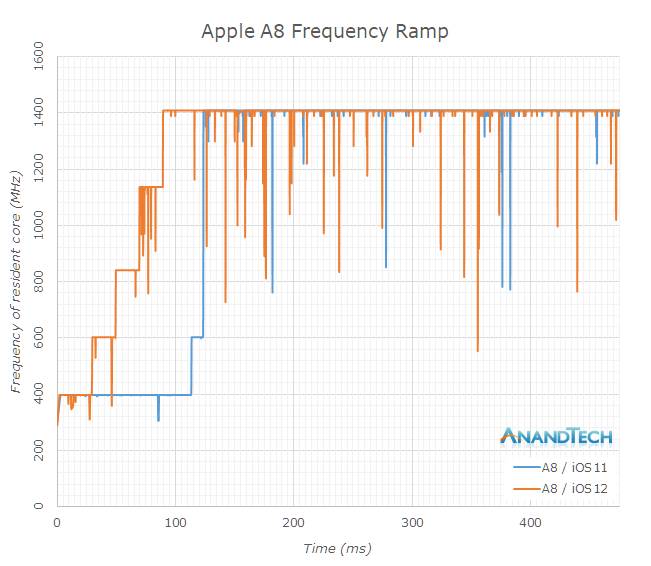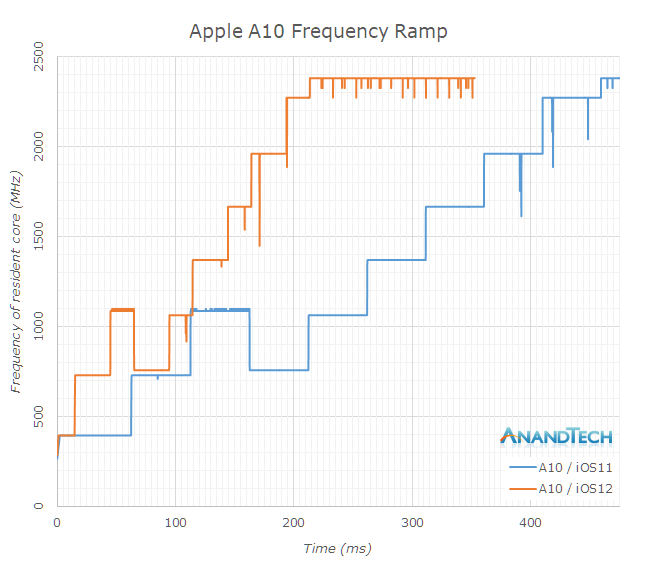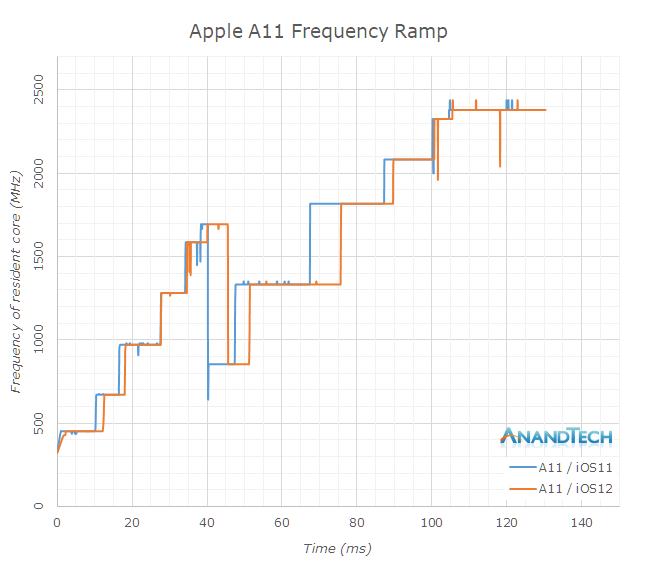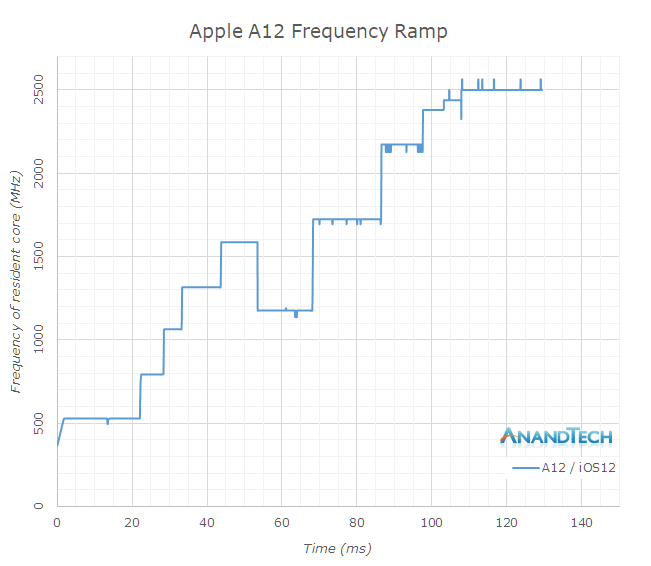The iPhone XS & XS Max Review: Unveiling the Silicon Secrets
by Andrei Frumusanu on October 5, 2018 8:00 AM EST- Posted in
- Mobile
- Apple
- Smartphones
- iPhone XS
- iPhone XS Max
System Performance
While synthetic test performance is one thing, and hopefully we’ve covered that well with SPEC, interactive performance in real use-cases behaves differently, and here software can play a major role in terms of the perceived performance.
I will openly admit that our iOS system performance suite looks extremely meager: we are only really left with our web browser tests, as iOS is quite lacking in meaningful alternatives such as to PCMark on the Android side.

Speedometer 2.0 is the most up-to-date industry standard JavaScript benchmark which tests the most common and modern JS framework performance.
The A12 sports a massive jump of 31% over the A11, again pointing out that Apple’s advertised performance figures are quite underselling the new chipset.
We’re also seeing a small boost from iOS 12 on the previous generation devices. Here the boost comes not only thanks to an a change in how iOS’s scheduler handles load, but also thanks to further improvements in the ever evolving JS engine that Apple uses.

WebXPRT 3 is also a browser test, however its workloads are more wide-spread and varied, containing also a lot of processing tests. Here the iPhone XS showcases a smaller 11% advantage over the iPhone X.
Former devices here also see a healthy boost in performance, with the iPhone X ticking up from 134 to 147 points, or 10%. The iPhone 7’s A10 sees a larger boost of 33%, something we’ll get into more detail in a little bit.
iOS12 Scheduler Load Ramp Analyzed
Apple promised a significant performance improvement in iOS12, thanks to the way their new scheduler is accounting for the loads from individual tasks. The operating system’s kernel scheduler tracks execution time of threads, and aggregates this into an utilisation metric which is then used by for example the DVFS mechanism. The algorithm which decides on how this load is accounted over time is generally simple a software decision – and it can be tweaked and engineered to whatever a vendor sees fit.
Because iOS’s kernel is closed source, we’re can’t really see what the changes are, however we can measure their effects. A relatively simple way to do this is to track frequency over time in a workload from idle, to full performance. I did this on a set of iPhones ranging from the 6 to the X (and XS), before and after the iOS12 system update.
Starting off with the iPhone 6 with the A8 chipset, I had some odd results on iOS11 as the scaling behaviour from idle to full performance was quite unusual. I repeated this a few times yet it still came up with the same results. The A8’s CPU’s idled at 400MHz, and remained here for 110ms until it jumped to 600MHz and then again 10ms later went on to the full 1400MHz of the cores.
iOS12 showcased a more step-wise behaviour, scaling up earlier and also reaching full performance after 90ms.
The iPhone 6S had a significantly different scaling behaviour on iOS11, and the A9 chip’s DVFS was insanely slow. Here it took a total of 435ms for the CPU to reach its maximum frequency. With the iOS12 update, this time has been massively slashed down to 80ms, giving a great boost to performance in shorter interactive workloads.
I was quite astonished to see just how slow the scheduler was before – this is currently the very same issue that is handicapping Samsung’s Exynos chipsets and maybe other Android SoCs who don’t optimise their schedulers. While the hardware performance might be there, it just doesn’t manifest itself in short interactive workloads because the scheduler load tracking algorithm is just too slow.
The A10 had similar bad characteristics as the A9, with time to full performance well exceeding 400ms. In iOS12, the iPhone 7 slashes this roughly in half, to around 210ms. It’s odd to see the A10 being more conservative in this regard compared to the A9 – but this might have something to do with the little cores.
In this graph, it’s also notable to see the frequency of the small cores Zephyr cores – they start at 400MHz and peak at 1100MHz. The frequency in the graph goes down back to 758MHz because at this point there was a core switch over to the big cores, which continue their frequency ramp up until maximum performance.
On the Apple A11 – I didn’t see any major changes, and indeed any differences could just be random noise between measuring on the different firmwares. Both in iOS11 and iOS12, the A11 scales to full frequency in about 105ms. Please note the x-axis in this graph is a lot shorter than previous graphs.
Finally on the iPhone XS’s A12 chipset, we can’t measure any pre- and post- update as the phone comes with iOS12 out of the box. Here again we see that it reaches full performance after 108ms, and we see the transition of the tread from the Tempest cores over to the Vortex cores.
Overall, I hope this is the best and clear visual representation of the performance differences that iOS12 brings to older devices.
In terms of the iPhone XS – I haven’t had any issues at all with performance of the phone and it was fast. I have to admit I’m still a daily Android user, and I use my phones with animations completely turned off as I find they get in the way of the speed of a device. There’s no way to completely turn animation off in iOS, and while this is just my subjective personal opinion, I found they are quite hampering the true performance of the phone. In workloads that are not interactive, the iPhone XS just blazed through them without any issue or concern.















253 Comments
View All Comments
Andrei Frumusanu - Saturday, October 6, 2018 - link
Eh no, it's single thread comparisons everywhere.Alistair - Saturday, October 6, 2018 - link
Thank you for making that clear. See my below comment with links, I put your data into a chart to compare. Is it fair to say IPC for the A12 in integers, is up to 64 percent faster?Hifihedgehog - Saturday, October 6, 2018 - link
Awesome! Thanks for the clarification. So my own education, is SPECint2006 a single-threaded test by its very nature? Can it be configured for multithreaded as well? If so, do you have multithreaded results forthcoming as well? I would love to see where Apple falls in this benchmark in that area as well.Andrei Frumusanu - Saturday, October 6, 2018 - link
SPECspeed is the score of running a single instance, SPECrate is running as many as there are cores on a system.It's not possible to run SPECrate on iOS anyhow without some very major hacky modifications of the benchmark because of the way it's ported without running in its own process. For Android devices it's possible, but I never really saw much interest or value for it.
Hifihedgehog - Saturday, October 6, 2018 - link
What about joules and watts? This is what is confusing me now. Something that seems a bit suspect to me is that the average energy and joule totals are not consistently lower together. That is, expect a device that has a lower average power usage to over the duration of the test to draw less total joules of energy. Mathematically speaking, I would naturally expect this especially in the case of higher benchmark scores since the lower power would be over a shorter space of time, meaning less total energy drawn.Andrei Frumusanu - Saturday, October 6, 2018 - link
The amount of Joules drawn depends on the average power and performance (time) of the benchmark.If a CPU uses 4 watts and gives 20 performance (say 5 minute to complete), it will use less energy than a CPU using 2 watts and giving 8 performance (12.5 minutes to complete), for example.
Dredd67 - Saturday, October 6, 2018 - link
I live in France and have to deal with intel radios since a while. I'm totally baffled to read all the comments about poor reception, dropped calls, wifi going crazy like this is news.This problem has been there since the beginning of Apple using intel chips ! It's just now that Americans have to use them also that it might finallybe adressed (please keep complaining, raise awareness, file a class action, whatever it takes) but you don't realize the pain these past years have been using an iphone elsewhere in the world...
For the record, I just gave my 7 (intel chip) to my daughter who broke here phone and reverted back to an old 6plus I kept for such cases (it also uses qualcomm). In the family I'm now the only only getting rock solid wifi, no dropped calls, consistent signal strenght, on a 4+ years old phone. And all this time I thought my carrier was messing around, my orbis were crap, or I just fumbled with my router settings.
Shame on you Apple, shame on you.
Oh and don't get me started on the camera: is this really what people want ? I think it's getting worse and worse, not better. Completely artifical images, looking more like cartoons than photographs. Same for Samsung and Google's phones. Hav a look at the P20 pro for a reality check. This is what photos should look like (contrast, colors - not really dependant on the sensor size).
Great review though.
ex2bot - Sunday, October 7, 2018 - link
The Halite app devs showed off an interesting technique they’re using or working on for the XS they call SmartRAW that may offer more control over the over saturation / lower contrast issues, etc.s.yu - Monday, October 8, 2018 - link
"Hav a look at the P20 pro for a reality check."?Your reality is the smeared textureless crap with oversharpening contours along object edges? Unbelievable.
serendip - Saturday, October 6, 2018 - link
Could these amazing CPU gains be translated to a midrange chip? Technically Android could run on Apple SoCs because they're all ARM licensed cores but porcines would gain flying abilities before that ever happened.It's too bad Android users are stuck with the best that ARM and Qualcomm can do, which isn't much compared to Apple's semi design team.